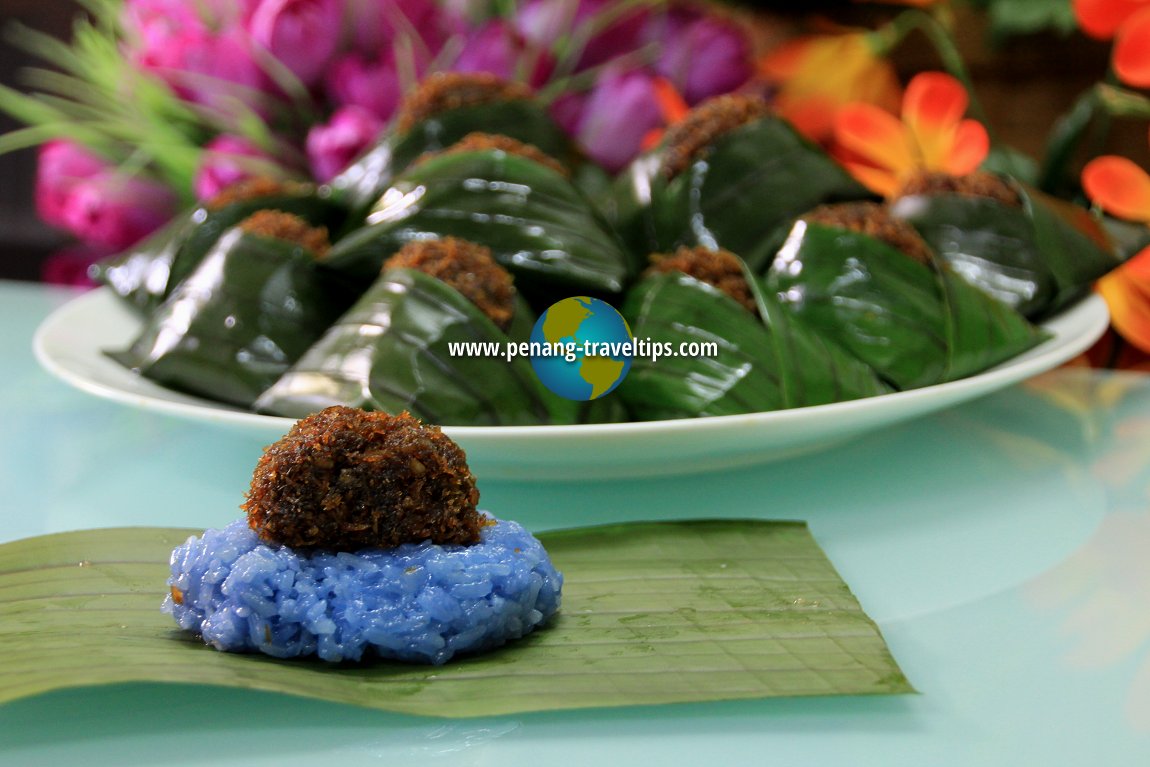
 Pulut Inti (23 March 2013)
Pulut Inti (23 March 2013)
Pulut Inti 椰丝糯米糕 is glutinous rice topped with grated coconut, and wrapped in banana leaf. It is one of the more popular Penang Nyonya Kuih, and is usually available from the kuih seller in most markets. However, nothing compares to homemade pulut inti, so if you have the time and inclination, you can try making it yourself at home.
The following are the steps taken by my wife to make the Penang-style pulut inti, based on the way her mother makes it. We usually collect bunga telang (butterfly-pea flower) which we dry and use whenever we want to make pulut inti, pulut tai tai and other Nyonya kuih. Depending on the bunga telang you use, you will need about a handful or 5g (even that small quantity may be too much). Some bunga telang releases its colour better than others, so you need to use your own judgement.
Pulut Inti Recipe
Utensils- 20 pieces of 13cm x 15cm banana leaf
- 2 pandan leaves
- pot
- strainer
- steamer
Ingredients
Pulut- 5g dried bunga telang (butterfly pea flower)
- 500g glutinous rice
- 250ml coconut milk (santan)
- 250ml water
- 1.5 teaspoon salt
- 300g grated coconut
- 250g brown sugar (gula melaka), adjust amount to your own preference
- 1/3 cup water
- a pinch of salt
- pandan leaves - knotted
Steps to prepare the Glutinous Rice
- Put the bunga telang in a bowl of hot water and soak it for 10 minutes. Press the flowers with a spoon to release its blue colour. Drain the water and pour it into the washed glutinous rice.
- Soak the glutinous rice in the blue bunga telang water for about four hours or overnight so that the colour goes into the rice. During this process, the rice will puff up, so make sure the water level is about 1 inch above the surface of the rice. Then strain away the blue water leaving only the rice.
- Drain the rice and put it in a tray in the steamer. Add the santan that has been seasoned with 1.5 teaspoons of salt (adjust to your own preference). Place one knotted pandan leaf on the rice, then steam the rice for half an hour or more, until the rice is cooked. Preferably the santan level must be of the same height as the glutinous rice. If softer rice is preferred, adjust the amount of santan accordingly. Half way through the steaming process, stir the rice with a ladle to free it up.
- Once steaming is completed, loosen the glutinous rice with a pair of chopsticks. Remove the pandan leaves from the rice.
Steps to prepare the inti and wrapping
- While steaming the rice, scald the banana leaves over open flame. Then cut the leaves into rectangles measuring about 13 cm by 15 cm.
- Mix the brown sugar, water and pandan leaves together in a small pot. Cook until sugar dissolves.
- Strain the mixture. Add in grated coconut and cook until the grated coconut lumps together. Set aside to cool.
- Put some steamed glutinous rice on a piece of banana leaf, top it with a tablespoon of coconut topping.
- Fold the two longer sides of the banana leaf to the center, leaving a bit of the coconut filling protruding from the center.
- Fold over the two ends of the leaf to form a leaf-wrap, and your pulut inti is done.
 The Pulut Inti before it is wrapped up. (23 March 2013)
The Pulut Inti before it is wrapped up. (23 March 2013)
 Dried Bunga Telang - we usually keep some in case we wish to make a kuih. (23 March 2013)
Dried Bunga Telang - we usually keep some in case we wish to make a kuih. (23 March 2013)
 Glutinous Rice dyed with Bunga Telang. (23 March 2013)
Glutinous Rice dyed with Bunga Telang. (23 March 2013)
 Banana Leaves (23 March 2013)
Banana Leaves (23 March 2013)
 Grated Coconut in brown sugar (23 March 2013)
Grated Coconut in brown sugar (23 March 2013)
 View of our homemade Pulut Inti unwrapped. (23 March 2013)
View of our homemade Pulut Inti unwrapped. (23 March 2013)
List of Penang Nyonya Kuih
Tim & Chooi Yoke's Recipes of Homecooked Food
Let us share our recipes of homecooked food with you.Details
About this website

Dear visitor, thank you so much for reading this page. My name is Timothy Tye and my hobby is to find out about places, write about them and share the information with you on this website. I have been writing this site since 5 January 2003. Originally (from 2003 until 2009, the site was called AsiaExplorers. I changed the name to Penang Travel Tips in 2009, even though I describe more than just Penang but everywhere I go (I often need to tell people that "Penang Travel Tips" is not just information about Penang, but information written in Penang), especially places in Malaysia and Singapore, and in all the years since 2003, I have described over 20,000 places.
While I try my best to provide you information as accurate as I can get it to be, I do apologize for any errors and for outdated information which I am unaware. Nevertheless, I hope that what I have described here will be useful to you.
To get to know me better, do follow me on Facebook!
Copyright © 2003-2025 Timothy Tye. All Rights Reserved.

 Go Back
Go Back
